
Celebrate ten years of Urban Omnibus and support ten more years of fresh, independent perspectives on citymaking with a donation today!
Celebrate ten years of Urban Omnibus and support ten more years of fresh, independent perspectives on citymaking with a donation today!
From time to time, our Urban Omnibus columnists check in to provide commentary on issues of design, policy, and history and their impact on the life and form of the city today. Read Stephen Rustow’s previous installments here.
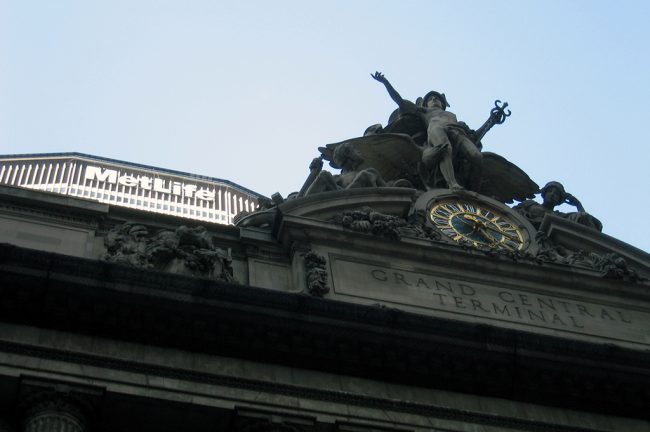
Grand Central Terminal and MetLife Building | Photo via Wally Gobetz
April 19th marked the 50th anniversary of New York City’s Landmarks Law, and the celebrations have been dignified, if a trifle self-congratulatory: among them an exhibition at the Museum of the City of New York with a lavish catalogue; several symposia; and a fair bit of press attention. And there is a great deal to celebrate: the law, signed by Mayor Robert Wagner in 1965, has saved over 30,000 discrete sites throughout the five boroughs.[1] Perhaps more importantly, the law has countered development pressures that at various moments threatened entire neighborhoods, from Brooklyn Heights (the first “preservation district”) to Bedford-Stuyvesant, the West Village, and Harlem. Seen in historical context, the Landmarks Law marked a sea change in our understanding of how the city should be made, a shift from urban design as a dramatic, fitful process of demolition and wholesale replacement to a gradualist approach of accretion and continual transformation. The Landmarks Law signaled the moment when Robert Moses lost to Jane Jacobs; New York would never be the same.
Americans, it’s said, are obsessed by their history because they have so little of it. But respect for the urban forms of the past has, in five short decades, become so thoroughly entrenched in New York’s image of itself that we may finally be secure enough to ask whether preservation is still a good strategy for a city that is struggling to redefine that image for the 21st century. And after five decades and 30,000 buildings, is there anything else left to preserve? Or more precisely, how much preservation do we need, of what kind, for whom, and why?

Designated historic districts (purple), individual landmarks (red), and interior landmarks (green) for portion of Manhattan, Brooklyn, and Queens | Click the image to see the full map at NYCLandmarks50.org
The Landmarks Law has an answer to this question: “the purpose of preserving buildings and places that represent New York City’s cultural, social, economic, political, and architectural history is to stabilize and improve property values; to foster civic pride; to enhance the City’s attractions to tourists; to strengthen the economy of the City; and to promote the use of historic districts, landmarks, interior landmarks, and scenic landmarks for the education, pleasure and welfare of the people of the City.” Thus fully three-fifths of the legislation’s rationale is economically grounded while the balance rests on civic pride and education.
There are further arguments for preservation that are implicit in the law. A sense of historical continuity clearly helps shape the city’s identity; the reuse of buildings also reflects a laudable frugality — in ecological terms, this is preservation as conservation. But there are perhaps some implicit fears hidden in the law as well: a fretful sense that the quality of today’s building seldom matches that of the past coupled with a popular skepticism about contemporary architectural experimentation that makes the past seem a safer bet.
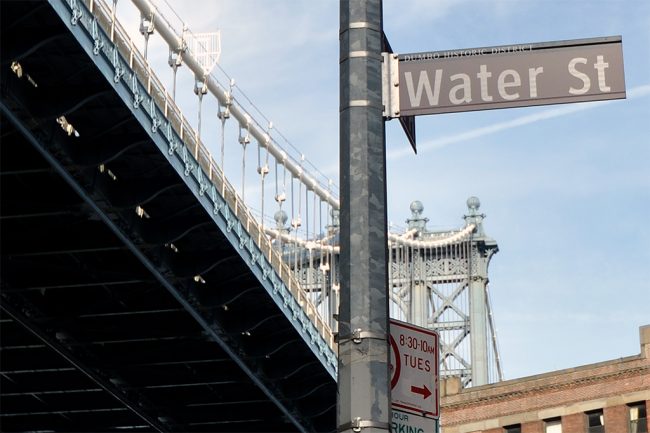
Sign for the Dumbo Historic District | Photo via DumboNYC
Operationally the preservation law constrains owners from demolishing designated buildings and controls the extent to which they can alter a building’s form. Nothing in the law precludes maintaining, improving, or even rebuilding portions of a landmark; indeed owners are actually compelled to a certain minimal upkeep of those features that elevated the building to landmark status in the first place. And as long as owners find such structures suitable for use or investment, landmark status imposes little hardship and may even create some additional value.
But the notion of value in New York is in constant flux, subject to changes in taste, changes in zoning, and an ineluctable aging of the building stock that leads to periodic efforts at “renewing” it. Zoning changes are the most difficult to predict because they redefine, in one fell swoop, all of the variables in the calculus that compares the return on an existing structure to the potential promised by its replacement. Landmarking adds another variable to that equation, expressing the presumed public interest in keeping a building that market calculations alone might not. Hence the complaint of many developers that landmarking a building actually diminishes its value by freezing total build-out below the allowed maximum and preserving forms that are less adapted to evolving demands for new kinds of space.[2]
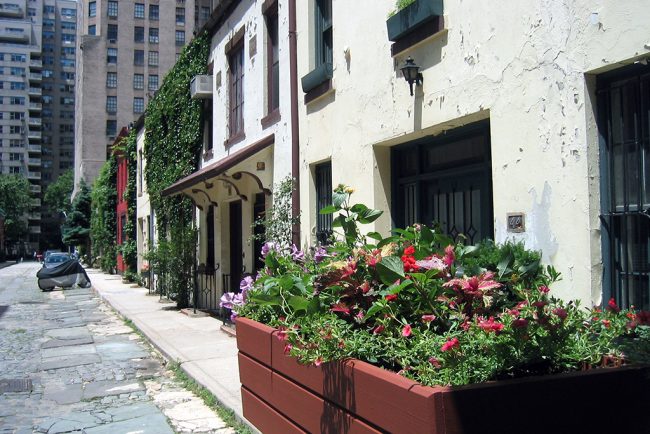
Washington Mews, part of the Greenwich Village Historic District | Photo via Wally Gobetz
And this position has a certain logic. After all, if both the form and function of the buildings we wished to preserve were viable, then no public action would be required to help the market do what the market does well: put value on things that are successful. The market only needs “help” when we decide to preserve something that it doesn’t value. So preservation is perforce concerned with forms at the expense of functions, or rather, preservation is ultimately concerned with inventing new functions that can live within forms that were originally conceived for other purposes.
The Landmarks Law acknowledges this divorce of forms from functions and “adaptive reuse” — finding new programs for old buildings — is one of its explicit goals. This helps explain why so many of the buildings listed as landmarks over the last 50 years have been firmly in the Beaux Arts tradition, and goes well beyond any compensatory guilt over the demolition of McKim Mead and White’s Penn Station, the original sin that haunts all local preservationists. The Beaux Arts design tradition valued representation, proportion, and arrangement and was largely indifferent to function, favoring an axial progression of spaces that was surprisingly similar whether the building was a courthouse, a library, or a museum. The Beaux Arts, particularly in its post-Columbian Exposition/City Beautiful version, was the baggy suit of architectural haute couture: a conventionally defined exterior form with enough extra material in the internal poché to be tailored to any use.[3]
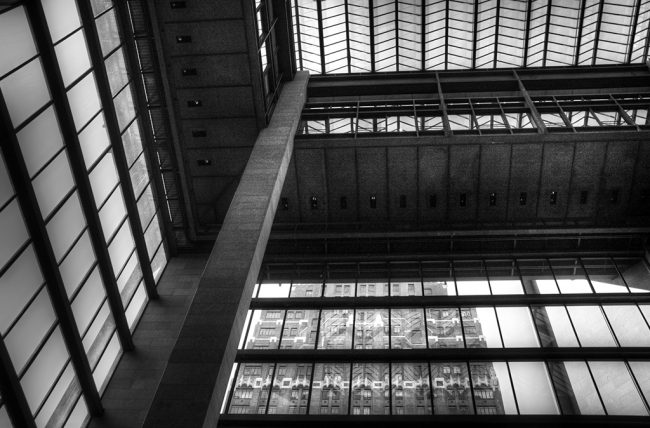
Atrium of the Ford Foundation Building, landmarked in 1997 | Photo via Joevare
Philosophically, preservation by adaptive reuse runs on a collision course with modernism, which held that a bank could no more resemble a pharmacy or a supermarket than a temple. But we live in a city where banks are regularly turned into Rite Aids and Trader Joe’s — and where even when banks were banks, they resembled temples. Modernism dictated an inalienable connection between the activities a building was intended to house and the character of the building itself: form followed function. Or more precisely, function projected form: the reasoned, patient search that produced architectural space was conceived at its heart as a prolonged meditation on function and site — these were the givens in which form, structure and materiality were to be discovered.[4]
But how do you preserve such buildings? How do you find new activities for containers that insist they were tailored to accommodate programs that have since disappeared? There are really only three choices: either you ignore modernist ideology and in preserving its stylistic progeny you contradict the very premises on which they were designed; or you don’t save them, that is, you follow modernist ideology to the nihilistic but logical conclusion of demolishing the building once its original program is defunct, thus placing your faith, as modernism did, in the ever-evolving ability of the present to invent new forms for new functions. The last alternative is to turn modern buildings into museums, where the programmatic subject is essentially redefined as the building itself.
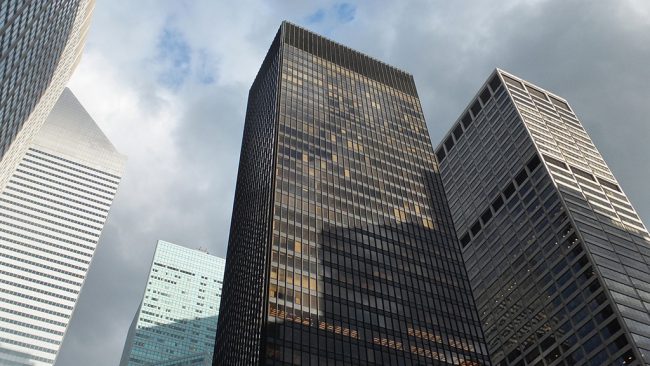
Seagram Building | Photo via Aidan Wakely-Mulroney
A telling instance of the modernist preservation dilemma has just played out in the Commission’s decision on May 19th not to allow changes to the Four Seasons restaurant, the stellar exemplar of mid-century modernist chic designed by Philip Johnson in the base of Mies van der Rohe’s undisputed masterpiece, the Seagram Building. The details of the story are at once highly specific to this particular case and broadly typical of landmark debates on modern design: the owner of the restaurant (a respected developer and patron of modern architecture) had proposed a series of changes to transform secondary spaces into service areas lacking in the original layout. To achieve this, his architect (herself a respected devotee of the modernist idiom) proposed re-working the detailing of some of the elevations, including a return to an earlier version of Johnson’s original project. The predictable hue and cry among the cognoscenti was quick and sharp, escalating rapidly into a virtual plebiscite on the very existence of the Landmarks Commission itself. Phyllis Lambert, the spiritual patron of Johnson’s design and the undisputed authority on all things Seagram, wrote in a New York Times Op-Ed that the changes proposed to the existing design “would undermine the meaning of landmark preservation in America.”
While Lambert conceded that the uninitiated were unlikely to notice the difference (that, indeed, the uninitiated were unlikely to find themselves dining at the Four Seasons in the first place) that, of course, was not the point. The point was the “responsible stewardship” of a masterwork of 1950s design, the moral obligations of the present to the past, et cetera. As the debate unfolded, the parsing of the finer points — the sub-division of surfaces and the nuance between fixed and operable panels — resembled nothing so much as those scholastic debates of the middle ages as to how many angels might dance on the head of a pin. Like those religious quarrels, there was here something at once deeply fateful to an entire system of historical dogma — and faintly ridiculous.
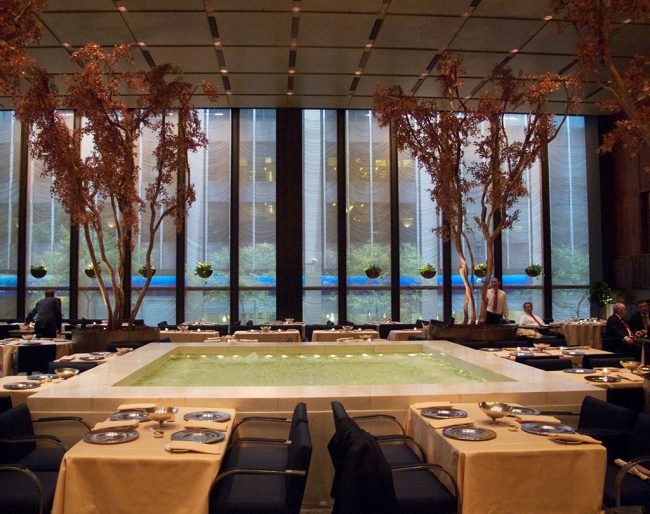
The Four Seasons’ Pool Room | Photo via Juan Monroy
Of course, it was Mies himself who famously insisted that God resided in precisely these details; but that deity had gone the way of the Four Seasons’ three-martini lunch long before Johnson put down his drafting pencil, as the ham-fisted detailing of his later work attests, just blocks away from Seagram. Indeed there was a delicious irony in debating the finer points of Johnson’s detailing; as a designer, Johnson was demonstrably indifferent to the finer points of his own work (tearing up and remaking several times, for example, his own undisputed masterpiece, the sculpture garden at MoMA) and gleefully callous in dealing with the finer points of his colleagues’ work (e.g., his lamentable 1964 hatchet job on the facade of Goodwin and Stone’s original MoMA building).[5]
But Johnson was arguably more of an optimist than those who would preserve him, and his whole career can be seen as a long, serious engagement with the material of the past to refashion it and explore its potential to generate something new. This seems a more promising, and ultimately more respectful use of the past than reflexively preserving it in aspic like a Four Seasons salad. In the hands of better designers than Johnson, we might start to see a vigorous exploration of contemporary forms engaging older ones to accommodate new programs. There are many instructive examples in Europe, from Scarpa to Moneo to Chipperfield, to name only the most obvious. Who knows, in time intelligent and respectful experimentation of this kind might go some distance in assuaging public skepticism about contemporary design; we might even get a few new landmarks in the bargain.
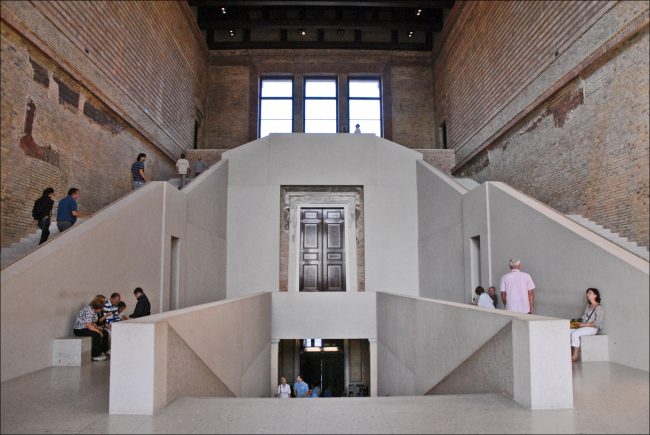
Inside Berlin’s Nues Museum as restored by David Chipperfield Architects | Photo via Jean-Pierre Dálbera
Indeed if New York were really secure in the embrace of its material history it might be a bit more relaxed about it, imagining a rich palimpsest of historical layers and erasures, a kind of visible archaeology of epochs and styles in which each era’s best buildings become source material to be carefully reused by the next. This might lead to both a physical and a semantic ecology, a real strategy of preservation as conservation, whereby each generation adapts the aesthetic and intellectual propositions it inherits to new ends rather than casting itself as the custodian of fixed designs for which it struggles to invent new uses. After all, if the Four Seasons ever left the Seagram, it’s not clear where one would turn for adaptive reuse: a Rite Aid or Trader Joe’s in the Pool Room doesn’t quite seem appropriate.[6]
It’s no doubt a good idea to keep Johnson’s restaurant just the way Ms. Lambert wants it; it’s always valuable to have a few exemplars of perfection and it seems unlikely that such refinements would threaten its suitability as a power lunch venue for years to come. But rather than taking past perfection as a model for the city as a whole, Johnson would certainly have been the first to advocate an attitude a little less dogmatic and a little more inventive. And New York might be the better for it.
NOTES:
[1] Even if the lion’s share of the individual buildings are in Manhattan.
[2] An argument preservationists hotly contest — indeed the biggest arguments between the two sides are about how buildings actually generate and sustain value.
[3] Adaptive reuse has been part of the preservation strategy even for buildings that still fulfill their original uses. In what can only be seen as an act of expiation for Penn Station, Grand Central has been vouchsafed an Apple Store, a Michael Jordan’s Steakhouse, and an upscale shopping mall, all the while accommodating up to a million commuters a day. The Landmarks Commission did not yet exist when the Pan Am (now MetLife) tower was erected on top of the north part of the station in 1963, however it did rule against another tower proposal by Marcel Breuer 5 years later. One of the highlights of the Museum of the City of New York show is reading from Marcel Breuer’s testimony in front of the Commission in defense of his ungainly 55-story project that would have swallowed the Warren & Wetmore building like a boa constrictor: “There is a divergence of opinion among intelligent and sensitive people,” said Breuer in testimony to the Commission, “as to whether Grand Central Station represents anything worth saving.”
[4] This was one reason why the question of flexibility became such a preoccupation of late modernism, for if one acknowledged that function or program was a fluid rather than fixed thing and that over time, often a very short period of time, the fundamental organization of activities in a building would necessarily change, then the inalienable connection of form to function was threatened and without that connection the modernist program had little meaning. The stopgap solution was to make flexibility part of the initial program so that the set of activities for which the designer designed contained, at the outset, a certain modicum of uncertainty and this could be understood and designed for as if it were one more piece of the function from which form would surely follow.
[5] Thus the original MoMA design of 1939, the first purpose-built modern art museum in the world and the earliest New York City example of the International Style, missed consideration for landmark status a year later thanks in part to Mr. Johnson’s alterations.
[6] Quite independent of the Landmarks Commission review, the developer has announced plans not to renew the lease of the Four Seasons when it expires in two years time and to create a new restaurant in the Seagram’s lobby.
The views expressed here are those of the authors only and do not reflect the position of The Architectural League of New York.